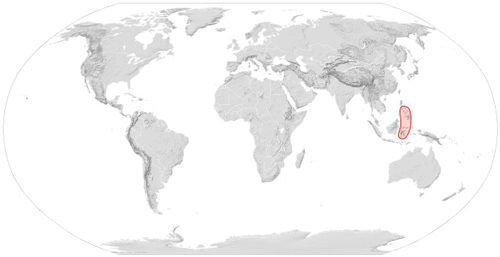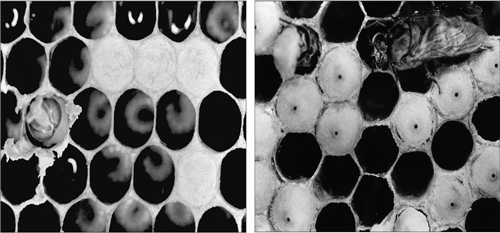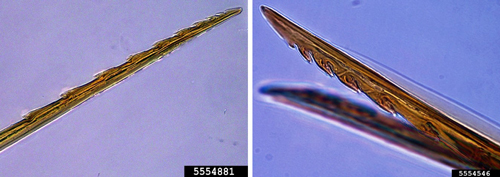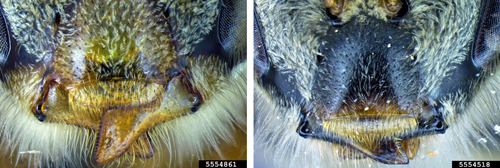common name: black-banded honey bee, Sulawesian honey bee
scientific name: Apis nigrocincta Smith (Insecta: Hymenoptera: Apidae)
Introduction - Distribution - Description - Biology - Economic Importance - Management - Selected References
Introduction (Back to Top)
Apis nigrocincta Smith (1860) is a cavity-nesting honey bee native to the Philippines and Indonesia (Burrows et al. 2020). It is sometimes referred to as the Sulawesian honey bee or the black-banded honey bee. At one time, this bee was thought to be a yellow morph of Apis cerana, the Asian honey bee (Hadisoesile et al. 1995). It was first established as a distinct species in 2001 when drone mating flight times were used to distinguish it from Apis cerana (Hepburn and Radloff 2011, Hadisoesile and Otis 1996). Apis nigrocincta is in the subgenus Apis along with Apis cerana, Apis koschevnikovi, Apis mellifera and Apis nuluensis (Engel 1999).
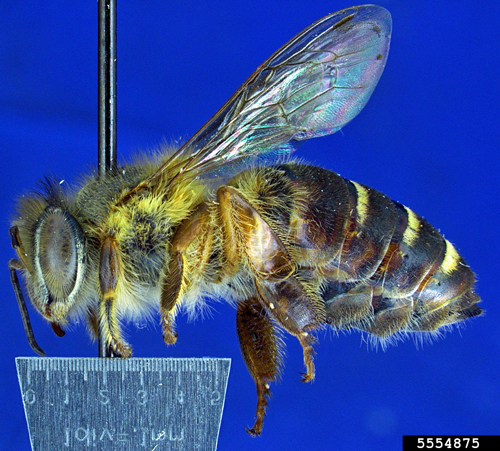
Figure 1. Adult Apis nigrocincta. Photographed by Allan Smith-Pardo, Exotic Bee ID, USDA APHIS PPQ, Bugwood.org
Distribution (Back to Top)
This honey bee is found exclusively in the southern Asian countries of the Philippines and Indonesia. Its distribution range has not been conclusively defined as little is known about the biogeography of Apis nigrocincta. In the early 1900s it was thought to be present in Borneo and extend up into China (Beccari 1904). Currently, it is predominately found in Sulawesi, Indonesia but it is also present in Mindanao, Philippines (Engel 1999) and Sangihe, Indonesia (Burrows et al. 2020) (Figure 2). Due to this species’ morphological similarities to Apis cerana, it has been suggested that Apis nigrocincta may have derived from bees moving south through Taiwan from China, eventually making their way into Sulawesi, Indonesia and the Philippines (Otis 1996).
Figure 2. Apis nigrocincta distribution. Created by © Sémhur / Wikimedia Commons / CC-BY-SA-3.0, or Free Art License.
Description (Back to Top)
Apis nigrocincta is thought to have diverged from Apis cerana within the last two million years. Due to their recent divergence, these species have many morphological similarities (Oldroyd and Wingsiri 2009), though there are a number of marked differences in the adult honey bees.
The eggs of Apis nigrocincta have not yet been described and morphological differences of larvae from Apis cerana and Apis nigrocincta have not yet been identified (Hadisoesilo and Otis 1998). The only described morphological difference of pupae between the two species is the drone pupae of Apis nigrocincta do not spin a thick pupal capping, nor do their cappings contain a pore (Figure 3). The lack of this pore is a defining feature used to differentiate Apis nigrocincta from Apis cerana (Hadisoesilo and Otis 1998).
Figure 3. Wax covering removed to show lack of thick drone pupal capping in Apis nigrocincta (left). Apis cerana drone cappings containing a pore (right) (Hadisoesile and Otis 1998).
Apis nigrocincta’s stinger is morphologically different from Apis cerana (Chaiyawong et al. 2001), appearing to have a slenderer lancet (shaft) and less pronounced barbs than that of Apis cerana (Figure 4). Apis nigrocincta is a medium sized honey bee that is slightly larger in size than Apis cerana, although a range of body length has not been documented for this bee. Apis nigrocincta also has a yellow clypeus (part of the insect face above the mouth) (Figure 5) and yellow hind femora (Keeling et al. 2001, Otis 1996) compared to Apis cerana’s darkly colored clypeus and hind femora. The body is covered with hairs ranging in color from yellow (Hadisoesile et al. 1995) to reddish-tan (Burrows et al. 2020) depending on the elevation that the individual was collected from (Hadisoesilo 1997).
Figure 4. Apis nigrocincta stinger (left) and Apis cerana stinger (right). Photographs by Allan Smith-Pardo, Exotic Bee ID, USDA APHIS PPQ, Bugwood.org
Figure 5. Adult Apis nigrocincta clypeus (left) and adult Apis cerana clypeus (right). Photographs by Allan Smith-Pardo, Exotic Bee ID, USDA APHIS PPQ, Bugwood.org
Apis nigrocincta and Apis cerana have similar forewing cubital indexes (a measurement between two specific locations on the forewing used to differentiate bee species) of 3.7 mm and 3.9 mm, respectively, and have the same forewing length of 7-9 mm (Burrows et al. 2020). However, they do have some anatomical structures differing in size that can aid in identification. Apis nigrocincta has a forewing radial cell basal length of 1.8 mm, an apical length of 1.1 mm, and a labial palp length of 3.7 mm while Apis cerana has the lengths of 1.2 mm, 1.8 mm and 1.8 mm of the same measurements (Hepburn and Radloff 2011). Apis nigrocincta has a slightly smaller proboscis length of 5 mm while Apis cerana has a length of 5.4 mm (Bakker 1999, Ibrahim and Chandel 2019). No male genitalia differences have been noted between the two species (Hadisoesilo 1997).
Biology (Back to Top)
Apis nigrocincta is a highly social, cavity-nesting honey bee. Its colonies are similar to other honey bees, consisting of a single egg-laying queen, female workers, and male drones. An average Apis nigrocincta colony consists of around 2,200 honey bees, smaller than an Apis cerana colony by about 600 bees (Bakker 1999). Apis nigrocincta colonies usually contain more drones than other members of its subgenus (Burrows et al. 2020).
The female Apis nigrocincta foragers tend to be most active in the early morning and can forage an average distance of 320 +/- 186 m away from the hive, depending on the day and the specific colony (Bakker 1999). Similar to other honey bee species, foragers dance to communicate food and nesting resource locations. Their round dances are performed for up to 25 m, at which point they switch to waggle dances to also convey the resource distance (Bakker 1999).
Like all other honey bee species, Apis nigrocincta undergoes colony-level reproduction through swarming. As a lowland species found only in tropical regions, these honey bees use fanning for thermoregulation at higher temperatures but it is not known if they are able to form clusters for thermoregulation in colder temperatures (Oldroyd and Wongsiri 2009).
Economic Importance (Back to Top)
Little is known about the pollination services provided by this bee, though Apis nigrocincta is a known pollinator of two species of coffee: Coffea canephora and Coffea arabica (Ngo et al. 2001). Apis nigrocincta is also thought to be a native pollinator of shrubs and bushes in Indonesia as well as some crops, such as cassava. There is also some speculation that Apis nigrocincta may even be important to the pollination of corn based on the presence of pollen in their hives (Bakker 1999).
Many years ago, Beccario (1904) suggested that Apis nigrocincta honey is produced in large amounts and consumed by the Dayak people of Borneo; however, given current knowledge on the distribution of Apis nigrocincta, it is possible that this honey was actually from a different honey bee species. Little else is recorded regarding the human consumption of Apis nigrocincta honey or hive products.
Management (Back to Top)
Apis nigrocincta colonies are occasionally managed by beekeepers in the Kamarora Village in Indonesia. These managed colonies are often the result of swarming Apis nigrocincta selecting to nest in empty hive boxes of the beekeepers (Bakker 1999). Apis nigrocincta colonies are host to Varroa underwoodi (Anderson et al. 1997) and Varroa jacobsoni but are not adversely affected by either mite species (Hadisoesilo and Otis 1998). Little else has been reported concerning the management of Apis nigrocincta.
Some researchers have shown that Apis nigrocincta prefer forest habitats (Hadisoesilo 1997) while others have described the bees’ nesting habitat as more varied (Bakker 1999). Regardless, there are large areas of Sulawesi being deforested to plant cash crops, destroying Apis nigrocincta nesting locations, possibly negatively impact their populations (Bakker 1999).
The Florida Department of Agriculture and Consumer Services — Division of Plant Industry’s Apiary Inspection Section is actively screening for invasive honey bee species in an effort to eradicate unwanted pests. This bee is not currently considered a threat to Florida, but state researchers are actively screening honey bees of unknown origins using molecular markers to detect the presence of Apis nigrocincta.
Selected References (Back to Top)
- Anderson DL, Halliday RB, Otis GW. 1997. The occurrence of Varroa underwoodi (Acarina: Varroidae) in Papua New Guinea and Indonesia. Apidologie. 28:143-147. https://doi.org/10.1051/apido:19970305
- Bakker DR. 1999. Foraging and habitat selection by two species of honey bee near Lore Lindu National Park in Sulawesi, Indonesia. Master thesis, University Guelph, Canada.
- Beccari O. 1904. Wanderings in the great forests of Borneo travels and researches of a naturalist in Sarawk. Archibald Constable & Co Ltd. London. 106 pp. https://doi.org/10.5962/bhl.title.50139
- Burrows S, Ritner C, Christman M, Spears L, Smith-Pardo A, Price S, Ramirez R, Griswold T, Redford A. 2020. Exotic Bee ID – Apis nigrocincta. USDA Extension Utah State University (27 May 2020).
- Chaiyawong T, Jayasvasti S, Suwannapong G, Wongsiri S. 2001. Scanning electron microscopic analysis of honey bees, Apis nigrocincta, A. cerana, A. koschevnikovi and A. mellifera stings. In Wongsiri, S. (ed.), Proceedings of the Seventh International Conference on Tropical Bees: Management and Diversity & Fifth Asian Apicultural Association Conference 19-25 March, Thailand. 121-128 pp.
- Engel MS 1999. The taxonomy of recent and fossil honey bees (Hymenoptera: Apidae; Apis). Journal of Hymenoptera Research 8: 165-196.
- Hadisoesilo S, Otis GW, Meixner M. 1995. Two distinct populations of cavity-nesting honey bees (Hymenoptera: Apidae) in South Sulawesi, Indonesia. Journal of the Kansas Entomological Society 68: 399-407.
- Hadisoesilo S, Otis GW. 1996. Drone flight times confirm the species status of Apis nigrocincta Smith, 1861 to be a species distinct from Apis cerana F, 1793, in Sulawesi, Indonesia. Apidologie 37: 361-369. https://doi.org/10.1051/apido:19960504
- Hadisoesilo S. 1997. A comparative study of two species of cavity-nesting honey bees of Sulawesi, Indonesia. PhD thesis, University Guelph, Canada.
- Hadisoesilo S, Otis GW. 1998. Differences in drone cappings of Apis cerana and Apis nigrocincta, Journal Apicultural Research 37: 11-15. https://doi.org/10.1080/00218839.1998.11100948.
- Hepburn HR, Radloff SE. 2011. Honeybees of Asia. Springer Science & Business Media. Springer, Heidelberg, Dordrecht, London, and New York. 7 & 11 pp.
- Ibrahim MM, Chandel YS. 2019. Morphometrics of Apis cerana from agroclimatic zones of Himachal Pradesh. Indian Journal of Entomology, 81(3): 406-410. https://doi.org/10.5958/0974-8172.2019.00116.0.
- Keeling CI, Otis GW, Hadisoesilo S, Slessor KN. 2001. Mandibular gland component analysis in the head extracts of Apis cerana and Apis nigrocincta. Apidologie 32: 243-252. https://doi.org/10.1051/apido:2001126
- Ngo HT, Mojica AC, Packer L. 2011. Coffee plant – poll.inator interactions: a review. Canadian Journal of Zoology 89:647-660. https://doi.org/10.1139/z11-028.
- Oldroyd BP, Wongsiri S. 2009. Asian Honey Bees: Biology, Conservation, and Human Interactions. Harvard University Press. Cambridge, MA and London. 32 & 172 pp.
- Otis GW. 1996. Distributions of recently recognized species of honeybees (Hymenoptera: Apidae: Apis) in Asia. Journal of the Kansas Entomological Society 69: 311-333.
